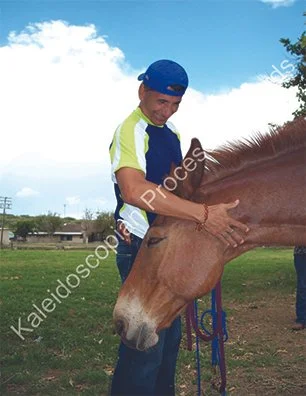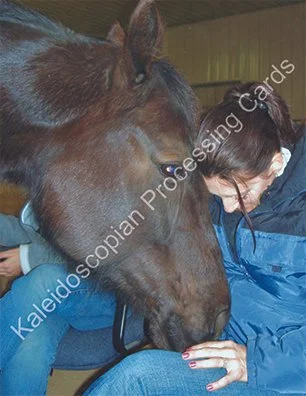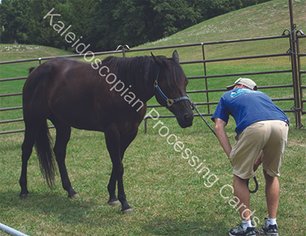CONFIDENCE
“We Left Our Barn Door Open” postcards with playful artwork telling people to “Hold their Horses” were mailed to Frankenmuth Chamber of Commerce members. The night before the big reveal, several friends helped with last minute cleaning of floors, setting up tables for displays, creating a welcoming place ready for guests. Randy helped me position my perfectly cleaned and detailed new dually with a four-horse slant trailer in the arena next to the roundpen. We placed plywood on the dirt floor deep into the arena near the conference room entrance, creating a stable foundation (pun intended). We ran power cords, covering them with guards into the space where the band would set up tomorrow afternoon.
Food was being prepared by a local caterer and artist, Val. She made custom tabletop signs for each dish with colorful images and descriptions, tucked neatly into horsey-themed bases. The plan was to have the horses at liberty in the roundpen, offering two short demonstrations of equine-assisted learning. All the little details were being given careful attention with the goal of providing locals with an remarkable first impression.
A few things would have to wait until the morning to be completed – the final picking of stalls, sweeping, and any last minute cleaning. Once we felt we’d done all we could for the night, the seven of us sat around drinking cold beer, swapping stories. Our laughter stopped when we saw headlights brightly through the front windows. Car doors slammed as my childhood neighbors, Bob and Sally, along with my Mom and Dad entered the conference room.
I crossed the room to greet them, “What are you doing here tonight? The Grand Opening is tomorrow evening?” I curiously inquired.
“We wanted to see your place, so we took a drive.” My Mother replied.
“We were just curious”, my Dad added. While Bob and Sally nodded their heads in agreement.
“Well, since you’re here would you like a tour?” “I’d love to show you the place.” I asked.
Noticing the people behind sitting around the custom-made kidney shaped island, they declined, explaining they just wanted to say congratulations. They turned to leave, murmuring platitudes about wishing me a successful event.
Once the door shut, I turned to my stunned friends, declaring, “If anyone ever wonders why I am the way I am, you just saw part of the reason why. Whose parents don’t want to attend one of the biggest events of their daughter's life?” Then, again, I mused out loud, “not one family members was interested in attending the graduation ceremonies for my Master’s or my Ph.D., so I guess we’re just not commemorative people.” I sarcastically added.
Deb stood up from the bar, crossed the room, wrapping me a tight, warm hug. I hugged her back, thanking her for the gesture. I then turned toward everyone, through tear-filled eyes, I thanked all of them for being “family”. Little did I realize how significant that statement would be in the very near future.
The morning of the Open Barn I hurriedly rushed to get chores done, mentally checking things off my list, matching them to the remaining amount of time I had left. I hoped to attend noon Rotary; planning to make an announcement about the party. I was hoping to encourage business leaders to come out for it on this cold February Thursday.
After I finished sweeping the aisle, I smoothly backed my shiny new tractor, with manure spreader attached, into the pole barn to get it out of sight of my future guests. I removed the cotter key from the hitch between the tractor and the spreader. Because I was rushed and not present, I absent mindlessly grabbed the 20,000 lb. tongue in an attempt to lower it. It took my right hand with it when it slammed on the concrete floor. Stunned, I quickly ripped my crushed fingers out from underneath the red metal monster. Blood gushed, squirting everywhere. I grabbed an old towel from a ledge in the pole barn, wrapping it around my torn fingers.
My first thought, as the throbbing started, was wondering how much aspirin related medicine I could safety take. I called my friend Sara who had once worked for a pharmaceutical company. I told Sara what happened, inquiring about the pain medicine.
“How many tylonal and how many advill can I take?” Not rattled by my question, she told me the amount then asked if I needed help.
“No”, I told her. “I planned to wrap a plastic bag around my hand, then take a shower. There was just enough time for me to get dressed, and still get to Rotary on time,” I replied.
Being right handed, I struggled to figure out how to tie the string around my right wrist so the bag would be waterproof. Unable to secure it, I called my future husband, Randy, asking him to come and help me. He said he’d be right over.
He took one look at my bloody and shredded middle and ring fingers, then declared we are going to med express. I protested. He was having none of it.
At our local med express, they unwrapped my hand, then laid it on the x-ray machine. The tech inappropriately said, “Wow, you really mangled it!” A few short minutes later, the tech came back into the room, telling us we would need to go to the emergency room in Saginaw. There was nothing they could do for us here. The two fingers were broken, the flesh needed to be stitched back together.
Randy drove me to the emergency room 20 minutes away. We checked me in, then found an uncomfortable bench in the waiting room, surrounded by others in various stages of distress.
Settling in to the reality that I might not make the grand opening and recognizing that I definitely was not going to be able to complete my finishing touches, I moved into problem-solving mode. I started calling in the troops – those people who I had confidence would step up and step in to make wonderful things happen. Each of them told me in their own way that they would “hold down the farm” until I got there. Trusting my friends would do their best, along with recognizing there was nothing I could do about it, I shuddered a deep, full body sigh then started sobbing on Randy’s shoulder.
I grieved the loss of what I imagined it would feel like to see all the cars driving in, greeting people, the pride of showing off the months of hard work, decision-making, and stress. I grieved the potential loss of my fingers. I cried tears of gratitude for friends who, without hesitation, made this event a priority, confident that they would exceed my expectations. I cried for the love and support I felt from Randy, appreciating his non-judgement and “being thereness” of the moment.
Shortly after I wiped my tears and the snot off my face, I heard my name called. We were checked into a room by the nurse, told to wait for the doc. Two white coated men came into the room and introduced themselves. One was the lead emergency doc, the other a resident in training.
The emergency doc unwrapped my right hand from the bondage the med express people had put on it. He poked it with a couple of shots for pain relief, then explained he’d be sewing them up, setting them with a splint. He also gave me a tetanus shot. It was a manure spreader accident after all.
He was kind, present, and genuine. He explained, while cutting a piece of plastic, that he was trying to create something to simulate a fingernail since mine was completely missing on my ring finger. He told me it was unlikely that the fingernail would grow back normally because of the injury. He suggested I see a plastic surgeon once the wound healed.
In case you’re wondering, I have a daily reminder of the accident because of the missing nail. A really fun hangnail grows every month or so and I haven’t painted my fingers nails in twenty-five years. Randy jokes I would get a finger-discount on a manicure.
I shared with the doctor that I was going to be throwing a party in about a half-hour for 200 of my closest friends. I explained that we had a couple kegs of beer, and that some of that cold brew had my name on it. I asked him if it be possible to be given pain killers that mixed okay with alcohol?
He shared that he was a home beer brewer, so he understood. He gave me two prescriptions. One beer-friendly for this evening. The second, stronger for the future. Small gestures of kindness can mean so much in difficult times!
We drove to the farm, past cars parked all along the driveway and the overflowing the parking lot. I walked into the conference room filled with smiling, joyful people happy to see I was okay.
After many, many hugs, pats on the back, and well wishes it was time for our demo. All the horses were moving comfortably around the roundpen enjoying the attention of the crowd in the arena surrounding them. I took the microphone, raised my bandaged right hand high, then explained that this was not a horse-related injury. I told them a rouge manure spreader had attacked me. Through tears, I shared how incredibly grateful and blessed I was for all the friends and family who helped make this dream come true!
Can you recall a time when you were confident you could count on others to represent you well?
What were the conditions that gave you that confidence?
What actions can you take in the future to create additional relationships that you can confidently count on?








